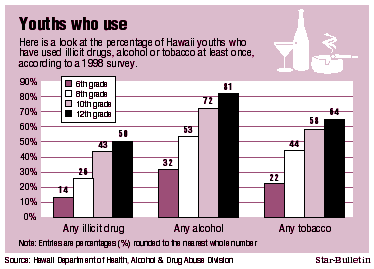

Isle students’
substance abuse
on the rise
Prevention programs
By Helen Altonn
should be strengthened in
all schools, the state says
Star-BulletinAn estimated 16,700 Hawaii students need treatment for alcohol and illicit drug use -- nearly double the number in 1996, according to a report released today.
Alcohol and marijuana are the most commonly abused substances, starting as early as the fourth grade, a 1998 Hawaii Student Alcohol and Drug Use Survey shows.
Eighth- and 10th-grade students reported more daily marijuana and alcohol use than students in those grades nationwide.
The survey covered 25,343 public and private school students in sixth, eighth, 10th and 12th grades.

Participating with parental consent were about 42 percent of public school students and 53 percent of private students.The Health Department's Alcohol and Drug Abuse Division and the University of Hawaii Speech Department conducted the survey in 204 public schools (only two on Oahu weren't involved) and 44 private schools statewide.
"We are real concerned about the results of the survey," division chief Elaine Wilson told community, education, treatment and youth officials today. "It is critical that every adolescent -- every youth -- who needs substance abuse treatment gets it."
State Health Director Bruce Anderson urged parents, businesses and the community to join his department in trying to address student drug abuse problems.
UH speech professor Renee Klingle, who conducted the survey with speech department Chairman Michael Miller, said there's not much change in the experimental use of drugs since a 1996 survey, "but those who are experimenting seem to be using on a more regular basis."
A continued increase in substance abuse by 10th- and 12th-graders is due largely to marijuana use, she said. Other illicit drug use generally declined or stabilized.
The good news, Klingle said, is that fewer kids are smoking or using tobacco in lower grades. The state's tobacco stings, intended to reduce retail sales of cigarettes to minors, apparently have been effective, she said.
Hawaii eighth- and 10th-graders use marijuana more frequently than do students in those grades on the mainland.
Except for eighth-graders, however, fewer Hawaii students reported using alcohol, cigarettes and smokeless tobacco in the previous 30 days (indicating frequency of use) than students nationwide.
Among other findings:
"One thing we found out is, our kids want to be educated," Klingle said. "They want it in the fourth grade."Treatment needs in Honolulu nearly doubled, from 8.1 percent in 1996 to 15.3 percent of students surveyed last year. However, the largest percentage increase was on the Big Island, with 20.7 percent, compared with 13.9 percent in 1996.
Treatment needs in Maui County increased from 12.8 percent to 17.8 percent; and in Kauai County, from 11.4 percent to 17 percent.
Use of alcohol at least once remained relatively stable. Daily alcohol use dropped in the 12th grade.
Use of cigarettes at least once dropped for sixth- and eighth-graders and leveled for 10th- and 12th-graders.
Daily use of cigarettes is lower in Hawaii than nationwide, but more eighth- and 10th-graders use marijuana and alcohol daily than students in those grades nationally.
The number of students using tobacco, alcohol and illicit drugs at least once in Hawaii generally are about the same or lower than national figures. But more Hawaii 12th-graders try methamphetamine than those nationwide.
Hawaii kids feel it's more difficult for them to obtain alcohol, tobacco and illicit drugs than it is for kids on the mainland.
She said fewer kids reported last year that their families were doing a good job educating them about alcohol and drugs.
The Health Department said substance abuse treatment should be a priority in every community and that prevention programs should be strengthened in every grade in schools.